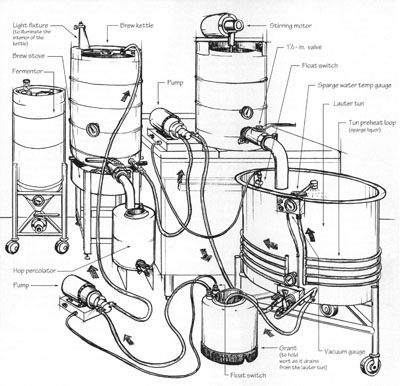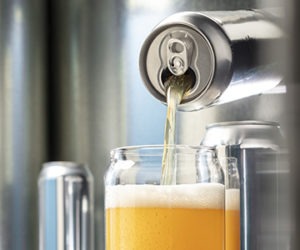Homebrewery Deluxe II
Randy Mosher started building his homebrewery around 1985. He began with an old Sankey keg that he modified to serve as a brew kettle. Since then his brewery has undergone many different permutations. Currently, he has a 15-gallon, three-vessel brewery with a separate mash and lauter vessel and boiling kettle. Numerous modifications make the Buckapound Brewery mostly automated. A skilled welder and metalworker, Randy built all of the equipment himself and named his brewery Buckapound because that’s exactly what he paid for it. Most of the equipment was built from scrap metal and parts that he found in junkyards and surplus shops. Mosher describes his brewery as “overcomplicated, but that’s the point.” For Randy, fabricating his own brewing equipment is as much of a hobby as brewing is.
Mash Vessel
Randy’s mash vessel is a modified keg. A large motor is connected to mash paddles that stir the mash. After mashing, the grain is released through a 11/2-inch valve that Randy calls a “glorping valve.” Even with a very thick mash, stirring reduces the mash to a consistency such that the mash will flow (or glorp) easily from the mash tun into the lauter tun when the valve is opened.
Lauter Vessel
The lauter tun is a large vessel with a false bottom. This vessel has a temperature gauge and a vacuum gauge. The vacuum gauge, which Randy modified from a gauge in a CPR dummy, measures the pressure at the bottom of the lauter screen. By watching this gauge Randy can judge if he is running off the wort too fast, especially in the early stages of the runoff. The outside of the vessel is covered with insulation.
Brew Kettle
The brew kettle, another modified keg, is equipped with a light fixture to illuminate the inside. Since kitchen cookware often incorportates copper layers, Randy has joined copper to the stainless steel on the bottom of the kettle. The copper provides for a more even distribution of heat, which in turn reduces scorching of the wort. He used an aluminum-bronze TIG welding rod to join the metals.
Hop Percolator
To get hop aroma into his beers, Randy has built a hop percolator. This hopback vessel is made from a 2-gallon Cornelius keg. Inside of the vessel is a perforated stainless bucket, salvaged from a scrapyard, that holds the hops. Randy cut the lid off the keg and sawed a “Cornelius hatch” out of it, which he then welded to a new scrap steel top. The hatch allows access to the inside. Wort flows from the kettle, through the hop bucket, and out through the valve in front to the wort cooler. The hop percolator can also be used to filter boiling hops from the hot wort.
Carboy
The carboy is perhaps the only storebought piece of equipment in the entire brewery. Although he has a homemade 12-gallon unitank fermenter, Randy sometimes still ferments in carboys.
Clean-in-Place Vessel
The clean-in-place (CIP) vessel takes the drudgery out of cleaning carboys and Cornelius kegs. The CIP is a tank made from a used keg, with a pump mounted underneath. You fill the tank with hot water and cleaning solution and the pump forces it out through the spray valve. The water is recirculated and can be drained and refilled as often as needed. It can be used two ways: You either invert your carboys or Corny kegs onto it, or you can attach a hose for spraying larger vessels.



